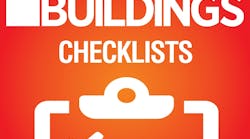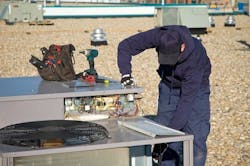Preserve the integrity of your roofing, lighting, HVAC and plumbing with our preventative checklist.
Are you practicing preventative maintenance? When you stay on top of upkeep, you avoid costly emergency repairs and equipment failures – all of which eat into your hard-earned budget. Use this checklist to keep major building systems – HVAC, roofing, plumbing and lighting – in good working order.
CHECKLIST: ROOFING
Save yourself from recurring issues and unexpected failures by using a roof asset management program.
This strategy syncs preventive maintenance and inspections with corrective action, ultimately extending the time between roof replacements.
- Inspect at least twice a year and after any severe storm.
- Create a roofing file for each building; review warranty information.
- Clear roof drains of debris (roof warranties don’t cover this).
- Walk the perimeter to examine sheet metal, copings, and previously repaired sections.
- Check roof-to-wall connections and examine flashings (at curbs and penetrations, etc.) for wrinkles and tearing.
- For single-ply roofs, re-caulk the top of face-mounted termination bars (if needed).
- For bituminous roofs, check for splits in the stripping plies.
- Be on guard against corrosion on metal roofs, which may be caused by condensate from copper coils in rooftop HVAC units. Duct the condensating water to keep it from coming into contact with the membrane.
- Keep traffic off of the roof to avoid membrane damage.
- Don’t let your green roof die from lack of care. Be attentive to plant health by monitoring growth and weeding and trimming as needed. Proper irrigation is not only critical for the survival of vegetation but also protects your roof membrane against leaks and ponding.
- Plan a moisture survey everyfive years to detect wet insulation or leaks.
- If you have a rooftop solar array, be aware that panels can become dislodged by a buildup of ice and snow. Inspect the racks and areas around penetrations during your regular walkthroughs. You can also mount ballasted systems on a pad to protect the roof membrane from possible damage.
CHECKLIST: HVAC
Spend some quality time with your heating and cooling equipment to preserve energy efficiency and indoor air quality.
- Inspect at least twice a year, with seasonal start-up and run inspections. Look for screw or latch updates, gasket repairs, and missing screws replacements. Also recharge P-traps or U-bend water traps for condensate drain pans.
- Seasonal PM of chillers and boilers is involved; industry practice is to have a qualified mechanical contractor provide services.
- For cooling towers, disassemble screens and access panels for inspection; inspect the tower fill, support structure, sump and spray nozzles, fill valve, gear box, drive coupling, fan blades, and motor bearings; clean starter and cabinet; inspect wiring; check motor starter contacts for wear and proper operation; megger test the motor and log readings; and check the condition of the sump heater and contactor, and log observations.
- Pumps usually require bearing lubrication at least annually. Inspect couplings and check for leaks. Investigate unusual noises.
- Air handling unit maintenance should include cleaning or replacing air filters at least once a month, though some may only need to be changed every 3-6 months.
- If you can reach the condenser coil, simply buy coil cleaner, apply and wipe off. If you need to remove panels to access the coil, use a licensed contractor.
- Periodically inspect settings for energy efficiency, particularly the compressor, refrigerant charge and thermal expansion valve (if applicable).
- In direct pressure systems, confirm that the superheat temperature falls between 10-20 degrees F. Look up the evaporating temperature per the manufacturer that corresponds with the measured suction line pressure, then measure the actual suction line temperature – the difference between these two numbers is the superheat temperature.
- Have an economizer? Dampers can malfunction if they become corroded or jammed with debris. Keep tabs on all moving parts, including the actuator and linkages, as well as seals. Properly calibrate sensors at least once a year.
CHECKLIST: PLUMBING AND RESTROOMS
A drip here and there may seem innocent, but leaks aren’t always visible to the naked eye. Start with bathrooms and explore larger building systems.
- Inspect at least annually; investigate any leaks or unusual noises.
- Domestic water booster and circulation pump systems require bearing lubrication at least annually; inspect couplings and check for any leaks.
- Domestic water heaters and boilers should be fire-tested periodically, using flue-gas analysis to adjust the flue draft and combustion air input to optimize efficiency.
- Remote drinking water chillers need condenser fan motor bearings lubricated annually. Check all contacts for wear and pitting, and run system control tests. Pump down the system and remove the refrigerant according to manufacturer instructions. Drain and replace oil in the compressor oil reservoir, including filters, strainers, and traps.
- Sump and sewage ejection pumps are replaced on an as-needed basis but should be checked for function. Exposed pumps should be lubricated annually.
- Fixtures, particularly those in public restrooms, often withstand heavy use and abuse. Check for leaks regularly and follow the manufacturer’s recommendations on how often to replace internal workings such as flappers, cartridges and diaphragms.
Stop Wasting Money on Deferred Maintenance
Every facilities professional knows maintenance is important to keep building systems and equipment functional.
But with shrinking budgets and limited staffs, it’s tempting to turn to a “run to fail” approach instead.
Stop doing that. It’s more wasteful of your time, energy and budget than you realize. Learn more...
CHECKLIST: LIGHTING
Haphazardly maintained fixtures can fail to deliver energy savings and lower light quality.
- Inspect at regular intervals, with group relamping when lamps begin to fail.
- Routinely check any luminaires that have transformers, control gear, or accessories, such as spread lenses, glare baffles, or color filters.
- Check exterior lights to make sure cables aren’t torn; all screws and hardware should be in place and working, and gaskets can be replaced to provide a better watertight seal.
- Replace any burned-out lamps and consider group relamping. To create your relamping schedule, calculate lamp life and how often lamps are used.
- Ensure that each lamp has the same color temperature.
- Re-aim adjustable lighting as necessary.
- Dust lamps and clean lens surfaces to enhance lighting performance.
- Because lighting elements can contain mercury or lead, it’s imperative to safely store used bulbs until they can be removed by a certified vendor. Ask for documentation to verify your waste went to a recycling facility and not the dump.
CHECKLIST: LONG-TERM ITEMS
- Electrical systems should be inspected by a licensed electrician every 3 to 5 years; PM typically includes checking switchgear, panel boards, and connections in addition to cleaning and re-torquing electrical connections. Overcurrent devices should be cleaned and lubricated as required; fusible switch units should be checked to make sure all fuses within the unit are from the same manufacturer and of the same class and rating. Note that arcing failures occur where connections have been loosened as a result of thermal cycling.
- Surfaces in parking garages should be cleaned at least twice a year, with coating replacement every 10 years. Power washing is a cheap, easy way to protect the structure and delay rehabilitation projects. Pavements should be crack-filled and seal-coated on a regular basis. Mill and overlay pavements should be done every 20 years.
Information provided by Richard L. Fricklas, former technical director at the Roofing Industry Educational Institute (RIEI); Mark Leeman, associate at Facility Engineering Associates; Bob Marvin, principal at Marvin & Associates Inc.; Walter M. D’Ascenzo, senior project manager at Facility Engineering Associates; and Jean Sundin, principal at Office for Visual Interaction Inc.
This article was originally published in 2009 and updated Dec. 2018.
Looking for more downloadable checklists?



